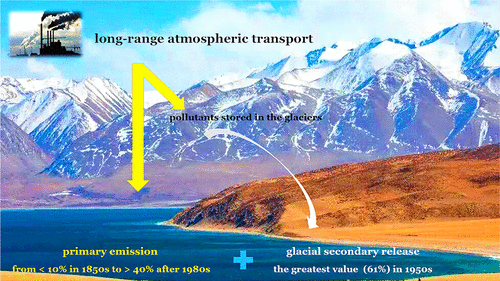当前位置:
X-MOL 学术
›
Environ. Sci. Technol.
›
论文详情
Our official English website, www.x-mol.net, welcomes your
feedback! (Note: you will need to create a separate account there.)
Accumulation of Pollutants in Proglacial Lake Sediments: Impacts of Glacial Meltwater and Anthropogenic Activities.
Environmental Science & Technology ( IF 10.8 ) Pub Date : 2020-06-04 , DOI: 10.1021/acs.est.0c01849 Tingting Zhu 1, 2 , Xiaoping Wang 1, 2, 3 , Hai Lin 1 , Jiao Ren 1, 4 , Chuanfei Wang 1, 3 , Ping Gong 1, 2, 3
Environmental Science & Technology ( IF 10.8 ) Pub Date : 2020-06-04 , DOI: 10.1021/acs.est.0c01849 Tingting Zhu 1, 2 , Xiaoping Wang 1, 2, 3 , Hai Lin 1 , Jiao Ren 1, 4 , Chuanfei Wang 1, 3 , Ping Gong 1, 2, 3
Affiliation

|
With global warming, the melting of glaciers can result in the release of pollutants into the environment. For remote Alpine lakes, both atmosphere-deposited anthropogenic pollutants and glacier-released pollutants can eventually sink in the sediment. To date, there has, to the best of our knowledge, been no attempt at quantifying the contributions of these processes to the accumulation of pollutants in glacial lake sediment. To fill this gap, a semi-enclosed proglacial lake located in the southern Tibetan Plateau was chosen and a 28 cm sediment core, which can be dated back to 1836, was used to explore the temporal trends of trace elements, Hg, and black carbon (BC) during the past two centuries. Geochemical indicators (Rb/Sr, Ti–Zr–Hf, and sedimentary rate) in sediment showed an overall continuous warming of the lake, while the temporal trends of fluxes of toxic elements and BC were broadly associated with their emission patterns. By using a positive matrix factorization model, the contribution of the anthropogenic source rose from <10% in the 1850s to >40% after the 1980s. However, the signal of glacial meltwater release was also distinct, and the greatest contribution of ice–snow meltwater reached up to 61% in the 1950s. Regarding the most recent two decades, 90% of pollutant deposition in the Tibetan sediment can be attributed to the combined forces of primary emissions and glacial release.
中文翻译:

冰川湖沉积物中污染物的积累:冰川融水和人类活动的影响。
随着全球变暖,冰川融化会导致污染物释放到环境中。对于偏远的高山湖泊,大气沉积的人为污染物和冰川释放的污染物最终都可能沉入沉积物中。迄今为止,就我们所知,还没有尝试量化这些过程对冰川湖沉积物中污染物积累的贡献。为了填补这一空白,选择了位于青藏高原南部的半封闭式冰河湖,并使用了一个可追溯至1836年的28厘米沉积物核,来探索痕量元素,汞和黑碳的时间趋势。 (BC)在过去的两个世纪中。沉积物中的地球化学指标(Rb / Sr,Ti–Zr–Hf和沉积速率)表明该湖总体持续变暖,而有毒元素和BC的通量的时间趋势与它们的排放模式广泛相关。通过使用正矩阵分解模型,人为源的贡献从1850年代的<10%上升到1980年代的> 40%。但是,冰川融水释放的信号也很明显,在1950年代,冰雪融水的最大贡献达到61%。关于最近的二十年,藏族沉积物中90%的污染物沉积可归因于一次排放和冰川释放的共同作用。冰川融水释放的信号也很明显,在1950年代,冰雪融水的最大贡献达到61%。关于最近的二十年,藏族沉积物中90%的污染物沉积可归因于一次排放和冰川释放的共同作用。冰川融水释放的信号也很明显,在1950年代,冰雪融水的最大贡献达到61%。关于最近的二十年,藏族沉积物中90%的污染物沉积可归因于一次排放和冰川释放的共同作用。
更新日期:2020-07-07
中文翻译:

冰川湖沉积物中污染物的积累:冰川融水和人类活动的影响。
随着全球变暖,冰川融化会导致污染物释放到环境中。对于偏远的高山湖泊,大气沉积的人为污染物和冰川释放的污染物最终都可能沉入沉积物中。迄今为止,就我们所知,还没有尝试量化这些过程对冰川湖沉积物中污染物积累的贡献。为了填补这一空白,选择了位于青藏高原南部的半封闭式冰河湖,并使用了一个可追溯至1836年的28厘米沉积物核,来探索痕量元素,汞和黑碳的时间趋势。 (BC)在过去的两个世纪中。沉积物中的地球化学指标(Rb / Sr,Ti–Zr–Hf和沉积速率)表明该湖总体持续变暖,而有毒元素和BC的通量的时间趋势与它们的排放模式广泛相关。通过使用正矩阵分解模型,人为源的贡献从1850年代的<10%上升到1980年代的> 40%。但是,冰川融水释放的信号也很明显,在1950年代,冰雪融水的最大贡献达到61%。关于最近的二十年,藏族沉积物中90%的污染物沉积可归因于一次排放和冰川释放的共同作用。冰川融水释放的信号也很明显,在1950年代,冰雪融水的最大贡献达到61%。关于最近的二十年,藏族沉积物中90%的污染物沉积可归因于一次排放和冰川释放的共同作用。冰川融水释放的信号也很明显,在1950年代,冰雪融水的最大贡献达到61%。关于最近的二十年,藏族沉积物中90%的污染物沉积可归因于一次排放和冰川释放的共同作用。











































 京公网安备 11010802027423号
京公网安备 11010802027423号